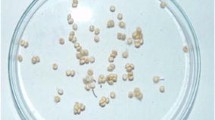Abstract
A sizeable population (60.5%) of muga silkworm (Antheraea assama Westwood, Saturniidae: Lepidoptera) enters pupal diapause in its natural environment in the wild state whereas the development is continuous when reared in the plains (0 to 20 m MSL) under human care (in this practice the larvae are mounted on the food plants with suitable leaves and protected from natural enemies and pass the entire larval stage in the out-door and rest of the development, viz. cocooning, pupation, moth emergence, courtship, copulation, oviposition and embryonic development etc. take place in in-door conditions; the ripe worms are collected from the food plants and put in the cocoonage; after cocoon formation the cocoons are placed in cages for moth emergence; if the moths do not couple naturally, mechanical coupling by gentle rubbing of the genital segments of the opposite sexes is resorted; finally the coupled moths are tied on a straw bundle for oviposition). Inbreeding of diapausing population in plain inhibits dormancy but intercross with the non-diapausing population channels a few pupae (3.5%) into diapause. Low temperature (6–10°C) and short photophase (9 to 10 hr) prevailing in winter in the hills (100 to 450 m AMSL) appear to be the threshold level to induce diapause in muga silkworm.
Résumé
Une grande population (60,5%) du ver à soie »muga« (Antharaea assama Westwood, Saturniidae, Lepidoptera) entre la diapause pupipare dans son environnement naturel dans l’état sauvage, mais le développement est continué quand on l’élève sous le soin humain [larves ont mis en position sur les hote-plantes au milieu de les feuilles suitables, ainsi qu’elles sont protégées des ennimies naturelles; cettes larves passent ses étages larvaire entierement dans l’éxterieur, et les autres étages de développement (la formation de cocon, pupation, l’émergence de la teigne, copulation, oviposition, développement d’embryo, etc.) dans l’interieur; les adultes obtainus de l’hote-plante ont introduis dans les coconages; après le formation de cocons, elles sont placés en cages pour l’émergence des teignes; si les vers ne s’accouplent pas naturellement, cette procès a mis artificiellement par frottement les organes genitaux des vers; finalement, les teignes qui s’accouples ont attachés avec une botte de paille pour l’oviposition] dans les plaines (de 0 à 20 m le niveau moyen de la mer). Le croisement consanguin de la population diapausant dans les plaines l’inhibe de dormir, mais entrecroise avec les canaux de la population non diapausante quelques pupes dans la diapause. La température basse (6–10°C) et la photoperiode courte (9–10 heures) pendant l’hiver dans les collines (de 100 à 450 m le niveau moyen de la mer) semblent d’etre le niveau du seuil pour produire la diapause dans le ver a soie »muga«.
Similar content being viewed by others
References
Denlinger D. L. (1978) The developmental response of flesh flies (Diptera: Sarcophagidae) to tropical seasons: variation in generation time and diapause in East Africa. Oecol. (Berl.) 35, 105–107.
Chaudhury S. N. (1962) Diapause and voltinism in some saturniids. Bull. Nat. Inst. Sci. (India) 19, 140–147.
Chaudhury S. N. (1981) Muga Silk Industry. 1st edn, 69–70, Directorate of sericulture and weaving Govt. of Assam, Gauhati, India.
Jolly M. S. and Sen S. K. (1969) Patterns of follicular imprints in egg shell — a species specific character in Antheraea. I. Bull. Ent. 10, 32–38.
Jolly M. S. and Sen S. K. (1974) Patterns of follicular imprints in egg shell — a species specific character in Antheraea. II. Indian J. serie. 13, 36–43.
Jolly M. S. and Sen S. K., Sonwalker T. N. and Prasad G. K. (1979) Non-mulberry silk. 1st edn, 77–81, FAO, Rome.
Thangavelu K. and Bhagomati A. K. (1985a) Studies on natural population of Antheraea assama Westw. (satur-niidae: lepidoptera) Sericologia 25 (1), 71–76.
Thangavelu, K., Bhagowati A. K. and Chakraborty A. K. (1985b) Induction of quiescence in muga silkworm, Antheraea assama Westwood. Curr. Sci. 54 (19), 1011–1013.
Wigglesworth V. B. (1973) The Principles of Insect Physiology. 7th edn, 111–119, The English Language Book Society, Chapman and Hall, U.K.
Author information
Authors and Affiliations
Rights and permissions
About this article
Cite this article
Thangavelu, K., Bhagowati, A.K. & Chakroborty, A.K. Diapause Potential in Muga Silkworm, Antheraea assama. Int J Trop Insect Sci 8, 61–63 (1987). https://doi.org/10.1017/S1742758400006974
Received:
Revised:
Published:
Issue Date:
DOI: https://doi.org/10.1017/S1742758400006974




